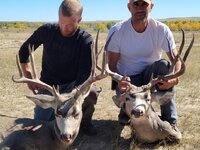I've been hunting the mountainous areas in MT for a while and have developed a good strategy for e scouting an area, finding a camping spot, glassing points, and where I think the deer will likely be. This year, I'll be hunting some more break like areas, like eastern MT and WY, where the terrain is mostly flat with breaks all over the place. The maximum topo difference where we will hunt is probably only 500 feet from the extreme low point to the highest. There are a ton of breaks that meander, bend, cut, and hide throughout the terrain. Some are drainages that are only a hundred yards long and some are miles long with a lot of off shoots. I've hunted the region before and had success but I think I can still hone a few things regarding terrain management to improve our odds at getting some good bucks.
I think I have a good handle on where the bucks like to hang out, I also think that I've got a good idea of areas where they prefer to bed. What I consistently struggle with is how to locate good glassing areas and how to set up and really take in an area during the early morning and late evening when the bucks are up and I want to sit and watch. I find that I'll think I've located a good area, I'll sit for a while and then think that I can't see enough so I'll move, wash rinse repeat. I've had success because like I said, we have a good handle on the area the bucks are in but our success has come mostly from "still hunting" and capitalizing on shot opportunities rather than a more controlled spot and stalk situation.
how do you folks handle terrain like this, where the bucks tend to be in the breaks below you and the terrain is so tight that it's hard to see any appreciable portion of it at once. Granted I can see the flat grassland on top fine but I rarely see bucks cruising these areas, almost all the bucks we've see have been in the cuts.
Thank you.
Splat
I think I have a good handle on where the bucks like to hang out, I also think that I've got a good idea of areas where they prefer to bed. What I consistently struggle with is how to locate good glassing areas and how to set up and really take in an area during the early morning and late evening when the bucks are up and I want to sit and watch. I find that I'll think I've located a good area, I'll sit for a while and then think that I can't see enough so I'll move, wash rinse repeat. I've had success because like I said, we have a good handle on the area the bucks are in but our success has come mostly from "still hunting" and capitalizing on shot opportunities rather than a more controlled spot and stalk situation.
how do you folks handle terrain like this, where the bucks tend to be in the breaks below you and the terrain is so tight that it's hard to see any appreciable portion of it at once. Granted I can see the flat grassland on top fine but I rarely see bucks cruising these areas, almost all the bucks we've see have been in the cuts.
Thank you.
Splat

